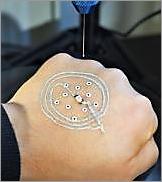
A new paper describes a low-cost 3D printing technology that could be used to print on skin temporary sensors for detecting chemical or biological agents, solar cells to charge electronics, or new types of skin grafts. The research was conducted by a team led by Michael McAlpine, the University of Minnesota Benjamin Mayhugh Associate Professor of Mechanical Engineering, in partnership with Jakub Tolar, dean of the University of Minnesota Medical School and director of the Stem Cell Institute, a Consortium member. The new 3D printing technique can be mapped onto each individual's skin contours and uses a specialized ink made of silver flakes that can be peeled off with tweezers or washed off with water. Prof. McAlpine notes, “It is such a simple idea and has unlimited potential for important applications in the future.”